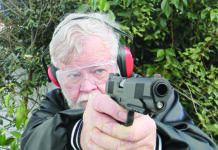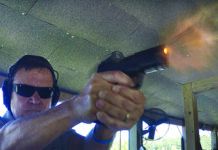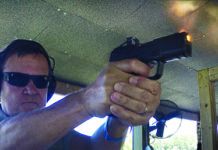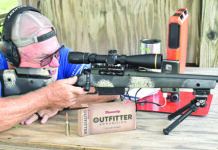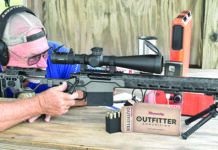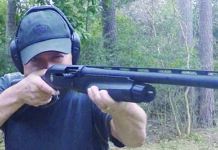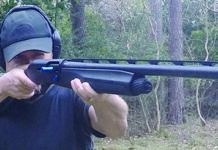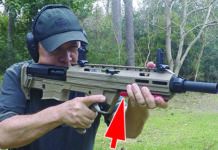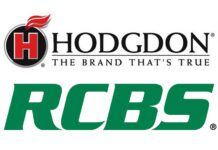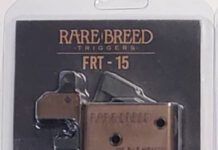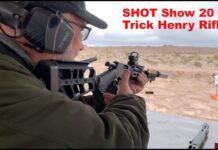Cowboy Action Shooting members, whose increasing numbers show no need of a stimulus package, have developed their hobby into a tribute to the gun battles of the Old West—both real and fictional. Shotguns often figured into these armed conflicts, normally giving the scattergun handler a distinct advantage over opponents armed with a handgun or rifle, as long as the battle was up close and personal.
One of Hollywood’s classic depictions of how a shotgun could turn the tide in a gun battle was in the 1966 movie The Professionals, featuring Academy-award-winning actors Lee Marvin and Burt Lancaster.
Marvin, armed with a Winchester Model 1897 pump-action shotgun, faces down eight mounted bandits armed with bolt-action rifles as they meet in a narrow canyon. With just a little help from Lancaster, himself armed with a Winchester lever-action rifle, Marvin clears the canyon of bandits as he touches off seven shotgun blasts in rapid succession. Most of the bad guys don’t even have a chance to get off a shot before they are knocked out of the saddle.
Although the battle is pure Hollywood, this type of shotgun action and its recreation on film has become a driving force behind the increasing popularity of the veteran firearms. Both the side-by-side hammer guns and the pump-action hammer guns of old left a distinct mark in history and are now resurfacing in the form of replicas finding favor at shooting competitions across the country. The popularity of the simple and easy-to-handle shotguns is also growing among people interested in home-defense firearms.
For our trip back to the past, we selected both a side-by-side and a pump action to see if there is any advantage or downside—other than the number of shots—with either Old West style shotgun.
Our test shotguns was a Cimarron Model 1897 Pump 12 Gauge Shotgun, carrying a price tag of $480 in the new gun rack at Dury’s Gun Shop in San Antonio (www.durysguns.com).
We selected three distinctly different types of ammunition for our testing. For the Cowboy-Action range, our ammunition was Rio Target 2.75-inch loads with 1 ounce of No. 8 shot that produced an average muzzle velocity of 1,210 fps. For our home-defense loads, we used Winchester 00 Buckshot 2.75-inch loads firing nine pellets at an average muzzle velocity of 1,325 fps, and Remington Express Power Piston 2.75-inch loads with 1.25 ounces of No. 6 shot pushed at an average muzzle velocity of 1,330 fps.
In the home-defense simulations, we limited our patterning tests to a range of 20 feet (recreating a shot across a typical room) and relied upon Birchwood Casey Shoot-N-C 12-inch targets to determine pattern effectiveness.
The Cimarron Model 1897 12 Gauge Pump Action, $480, is a replica of the classic Winchester Model 1897, and the feel and balance of the modern version remains a classic.
We liked the heft and handling ability of the shotgun, but were a little concerned about the stiffness of the action. However, after a little test time and shell shucking, the pump became a smooth-functioning tool. Only a few minor malfunctions marred its performance on the range.
Just a little longer than the Model 1878, measuring 39.75 inches in overall length with its 20-inch barrel, the stock dimensions were also a more comfortable to our test team. The drop at the comb was 2 inches and the drop at the heel was 2.75 inches, which is more similar to a field gun than the side-by-side. The length of pull of 14.75 inches was just a little longer than some of our team members would like, but after a little adjustment time did not pose any significant problems.
Lighter than the side-by-side, the unloaded weight of the Model 1897 was exactly 7 pounds, and the trigger pull was a very nice, crisp 5.25 pounds.
An added feature that we appreciated was screw-in chokes (one Improved Cylinder tube was included in the package, but others are available by special order). While most of the work with this shotgun would be close in and would not require extensive choke adjustments, the option of opening up or tightening up is nice to have available.
Putting the shotgun to the patterning board test, we were generally impressed with the pump’s performance. There were only a few hits of both 00 and No. 6 shot outside of the 10 ring, and only one or two flyers with the smaller shot outside the 12-inch circle of the target. This type of shot pattern, like the tight hits of the Model 1878, provide excellent stopping power for home-defense situations.
Loaded to the max with six shells in the magazine and one in the chamber, the slight weight increase was only barely noticeable, and the handling ability was actually improved. Multiple steel plates or close, trap-style targets were a pleasure to smack down with the pump.
Our Team Said: The pump action was just a little stiff on this recreation of the Winchester classic, although the action became smoother after a little test time. We were impressed with the handling ability, balance and patterning performance. We would consider the pump action a good choice for either Cowboy Action service or home defense. We would recommend a little break in time for both shotguns. Only one failure to feed a shell was encountered as we put the pump through its paces—well within our acceptable range. In the end, we agreed that if more than two shots were required in a shooting situation, the Cimarron pump action shotgun would be a fine choice.



